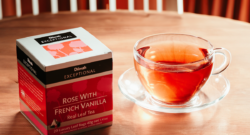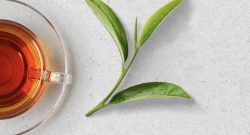Author: Shehani
Swipe Right for Love (Cake)
If you are a Sri Lankan, or live in Sri Lanka, or have any Sri Lankan friends in your life, then chances are that you’ve already met Love Cake. She is regal, has great taste and – like her name suggests – is much loved by one and all. Above all, she is currently on the look-out for the perfect cuppa to be her best match. This Valentine’s season, Love Cake is making a special appearance at t-Lounge by Dilmah, in the form of a beautiful boxed selection with four different tea-inspired glazes. There’s a vibrant green glaze infused with the soothingly earthy yet upliftingly refreshing Dilmah Moroccan Mint Green Tea. There’s a beautiful blush glaze infused with the sweetly floral, aromatic Dilmah Rose with French Vanilla Tea. The mellow tan number is a contrastingly vivacious, piquant Ceylon Cinnamon glaze. The Classic glaze takes on a distinctively plain white colour. Beneath each of these toppings lies Love Cake, in all her pomp and tradition, prepared to perfection using age-old recipes tweaked by the brilliant culinary team at t-Lounge by Dilmah. It’s an eye-catching presentation with a taste of novelty, thoughtfulness and love. Ancestral History Love Cake’s great ancestors are believed to have been of Portuguese origin, having arrived on our little island back in the 16th century. They originally went by the name of ‘Bolo di Amor’, before integrating into local culture, taking on local flavours and evolving into the name that we all recognise instantly – Sri Lankan Love Cake. Why ‘Love’ Cake? one might ask. There are a couple of schools of thought as to how this name came about. It is, of course, an almost direct translation of the Portuguese name, with ‘bolo’ translating to coarse cake, and ‘amor’ meaning love. Some believe that the name came about as a result of the ‘labour of love’ that it was to prepare the cake, using rich ingredients, too. Another more intriguing theory is that this special cake was used by young maidens to woo potential suitors. Whatever the reasoning, the name has been lovingly preserved and passed down through generations. Love Cake in Sri Lanka Fast forward several centuries, and the popularity of Love Cake in Sri Lanka has only flourished. She is highly sought after not only during festivities such as Christmas season, weddings and Valentine’s Day, but is also fondly gifted and served when meeting and greeting local and foreign friends, alike. Love Cake’s unique and distinguished character comes from the staple ingredients that the Sri Lankan version is unmistakably enriched with – semolina, cashew, pumpkin preserve, rose water and almond essence. It makes for an aromatic affair, with the crusty top, nutty center and dense base making every encounter a journey to savour in itself. Finding the Perfect Pairing Like we said, Love Cake is currently on the hunt for the perfect tea to her cake. The suitors are many in number, and the sorting process has been a task. However, after chewing on it and letting it brew for a while, we’ve managed to narrow the options down to three potential matches: . Dilmah t-Series Brilliant Breakfast Tea, a bold, brisk and bright tea from the Dimbula Valley that arouses the palate and senses with its robust liquor. . Dilmah t-Series Rose with French Vanilla Tea, a bright Nuwara Eliya region tea with sensual floral notes from red rose combined with the soothing, sweet aroma of French vanilla. . Dilmah t-Series Italian Almond Tea, a malty, mellow tea from the Nawalapitiya region, laced with the nutty and bittersweet aroma and flavour of Italian almond. As you might have seen on our socials, Dilmah Chairman Dilhan believes that Brilliant Breakfast is the perfect match for Love Cake, while his beloved wife Serena is rooting for Rose with French Vanilla. Here at Dilmah HQ, a few of us think that Italian Almond might be the best suitor. What do you think? Check them out and let us know! ‘You’re the Cake to My Tea’ Love Cake boxes are available at t-Lounge by Dilmah in Sri Lanka on a pre-order basis until 15th March 2025. DM @teatimerocks to place your order now. Dilmah t-Series specialty teas are available for purchase at Dilmah Tea Boutiques and t-Lounge by Dilmah outlets in Sri Lanka, and can be ordered online globally.
Merrill J. Fernando: An Autobiography
Within the Dilmah Family, we fondly refer to him as ‘MJF’. Older generations of the trade simply called him ‘Merrill’, while younger generations referred to ‘Mr. Fernando’. Around the world, he was often recognised as ‘Mr. Dilmah’. Regardless of the moniker, it is, of course, our beloved Founder Merrill J. Fernando that we speak of. To many, he was the founder and face of Dilmah Ceylon Tea since 1985. A passionate teamaker who poured his life and heart into his tea, it is no secret that MJF was a disruptor of the colonial tea trade system in his early years, taking a stand against unscrupulous processes that gave local tea growers a raw deal. A force to be reckoned with, is what he was – and continues to be in our memory, even today. If ever you had the honour of speaking with him in person, you would have undoubtedly been humoured by his undeniable wit and sharp tongue, while also feeling a sense of awe towards his intelligence and vision. This vision was not limited to his business, though, for MJF was a strong believer – and example – of business being a matter of human service. This human service is something that Dilmah still extends towards less fortunate communities, differently abled children, marginalised women, endangered species, the natural environment, and beyond. He was a God-fearing man with a deep sense of religion and responsibility. Most of this might already have been known to those who knew MJF and his work closely enough. So, in May 2023, months before bidding farewell to the mortal realm, Merrill J. Fernando published his memoir – The Story of Ceylon Teamaker Merrill J. Fernando. The transcript, expertly documented by Anura Gunasekara under MJF’s keen eye, gives us in-depth insight into a life that inspired not only second and third generations of tea growers and teamakers within the family, but generations of tea enthusiasts the world over. As you make your way through the pages, you get to know the ordinary child who grew up to be an extraordinary entrepreneur, philanthropist and advocate for Ceylon tea. You see how this magnanimous figure was so much like you and me in terms of life, yet also how he had used his vision and purpose to transcend beyond that likeness, while remaining humble and committed through it all. The book is an account, an album, a documentation of MJF’s personal, professional and family life, the evolution of Ceylon tea, the political and administrative history of the country, the growth of Dilmah and numerous other brands now associated with the MJF Group. As you skim through, you come across a trove of intriguing historical facts and anecdotes, and a plethora of rare images that cover everything from family holidays and weddings, to the Dilmah/MJF family that extends beyond the Fernandos, the brand’s growing network of global friends, colonial and post-colonial photos, documents and articles from the trade, Dilmah’s global advertising campaigns from the early years, contributors and stakeholders at the heart of the business, and so much more. It is an easy read, an open invitation into the life and mind of a man who used his wisdom, resilience and grit to achieve greatness for both self and country. The book is an ode to his humble beginnings and a testament to the noble and magnificent gentleman we knew him to be at the time of his passing. Above all, in his own words, it is “a tribute to many people and a grateful acknowledgement of the contribution made to (his) life by so many”. It really is quite something, coming from the legend himself. The Story of Ceylon Teamaker Merrill J. Fernando is now available for purchase at Amazon: The Story of Ceylon Teamaker: Merrill J. Fernando: Merrill J. Fernando: 9789550081325: Amazon.com: Books
Valentine’s Month: Rose with French Vanilla Tea-Inspired Recipes
Love it or not, it is officially the ‘month of love’ for 2025. So, we thought of sharing a few simple recipes that you can easily put together to show some love to that someone special, or to all the special people in your life – yourself included. The star of these tea-inspired recipes is our tea of the month – Dilmah Rose with French Vanilla Tea. You may also use Dilmah Exceptional Rose with French Vanilla tea bags instead. We’ve put together something hot and spicy, something smooth and chilled, and something sweet and fun to take your pick from. Go ahead, try them all! RECIPE 1: Baileys Chai (tea-inspired hot chai cocktail) What you need: How to prepare: RECIPE 2: Rose with French Vanilla t-Faluda (tea-inspired chilled shake) What you need: How to prepare: RECIPE 3: Rose with French Vanilla Marshmallows (tea-inspired sweet treat) What you need: How to prepare: In case you’re feeling a little more adventurous, there are plenty more Dilmah Rose with French Vanilla Tea-inspired recipes of varying complexities to be found at teainspired.com.
Pitch to Pitch
We’re in the middle of a unique sequence of events, built around Sri Lanka’s – and Dilmah’s – longstanding friendship with New Zealand. It’s called Pitch to Pitch, and at the heart of the entire programme is a sentiment that we love – kindness. Pitch to Pitch is in fact part of the New Zealand High Commission in Sri Lanka’s initiative to encourage New Zealand citizens to visit our beautiful island. The Sri Lanka National Women’s Cricket Team, Soul Sounds choir, the Sri Lanka Australia New Zealand Business Council, along with Dilmah Ceylon Tea and other businesses have come together to support the New Zealand High Commission’s kind effort towards the initiative. A couple of aspects are apparent here – the strong cultural ties between the two countries, and the appreciation of remarkable Sri Lankan women who have contributed towards enhancing Sri Lanka’s global repute. The National Women’s Cricket Team are the reigning Asia Cup champions, and are currently in the midst of preparing for their highly-anticipated tour of New Zealand in February this year. Soul Sounds, Sri Lanka’s very own international award-winning, all-girl choir, led by the incredibly talented Soundarie David, carry fond memories of New Zealand, too, as they grabbed two gold medals at the World Choir Championship held in Auckland last year. Where does kindness come into all of this, one might wonder. Well, it began with the first event that took place on 22nd January – a visit by the Women’s Cricket Team and Soul Sounds to Suwa Arana, run by Indira Cancer Trust. Here, these commendable women unwrapped the gift of joy among dozens of children receiving cancer treatment by spending time with them and leading them through sport and music activities. It was also a wonderful opportunity for us at Dilmah and the MJF Foundation to reignite and relive the philosophy of our beloved late Founder Merrill J. Fernando that business is a matter of human service, and that kindness should be at the core of whatever we do. The next event is set for 29th January, when the Soul Sounds choir will visit the Women’s Cricket Team at a training session, empowering one another with a kind and inspiring exchange of knowledge and skills – from one ‘pitch’ to another. Finally, on 20th February, the Women’s Cricket Team will be given a festive send-off at Sri Lanka Cricket Head Quarters prior to their departure for New Zealand. However, the actual VIPs at the event will be the incredibly brave kids visiting from Suwa Arana and from the SOS Children’s Villages in Sri Lanka. Another little gesture of kindness to put a smile on their beautiful faces. Keep an eye out on our socials for images and reels from these events. Update (25/02/2025): Here are a few images from the farewell event held for the Sri Lanka Women’s Cricket Team prior to their departure to New Zealand. Soul Sounds choir graced the event with their impeccable vocals.
Myth Busters 2: Milk and Caffeine
Let’s look at a couple of misleading perceptions pertaining to drinking tea with milk, and the caffeine content of tea, which Tea Grower and Dilmah Chairman Dilhan C. Fernando categorically classifies as Tea Myths. Tea Myth: Adding milk to tea reduces its benefits. Busting the Myth: The tea brewing process extracts antioxidants from the tea leaf into the liquor. Once brewing is complete, the antioxidants from the tea have already been extracted into your cup. Hence, adding milk – or any other liquid element, as with tea mocktails and cocktails – does not have an impact on the antioxidant potential of your tea. The addition of other enhancements such as herbs and spices, too, will only add the respective health benefits of those ingredients, with no detrimental effect on the health benefits of the tea itself. If you’d like to know more about the antioxidant capacity of tea, read more here. Tea Myth: Tea contains too much caffeine. Busting the Myth: As per the European Food Safety Authority’s (EFSA) recommendations, for an individual with a body mass of 50kg, it has been deemed safe to consume up to 150mg of caffeine per day. In comparison to an average of 100mg of caffeine per serving of coffee, a serving of tea typically contains around 20mg of caffeine. This implies that for a person with a healthy body mass index (BMI), it is completely safe to consume between 4-6 cups of tea in a day. Uniquely, tea is the only agricultural crop that contains L-theanine, a non-protein-forming amino-acid that is known to reduce anxiety and stress without bringing about drowsiness. Hence, in synergy with the small amount of caffeine present in tea, a cup of tea would be the best option to pique your alertness while maintaining your calm. Also see Myth Busters 1: Black Tea and Tea Dust.
Myth Busters 1: Black Tea and Tea Dust
Let’s look at a couple of misleading perceptions pertaining to black tea and tea dust, which Tea Grower and Dilmah Chairman Dilhan C. Fernando categorically classifies as Tea Myths. Tea Myth: All black teas taste the same. Busting the Myth: All it takes is a single look at the Single Region Watte series of teas to get an idea of how versatile black tea can be. Derived from the same Camellia sinensis plant and manufactured using the same processes, these four distinctive teas – from the Nuwara Eliya, Dimbula, Nawalapitiya and Ratnapura regions – get their unique characteristics as a result of the elements of nature in these respective regions. Starting from the highest elevation of 6,000 ft above sea level, the Watte tea from Nuwara Eliya looks and tastes lighter and brighter, and this transitions into a more malty, earthy, strong and intense colour and taste as elevation reduces and, subsequently, climate and terroir vary. So, while all your black teas are, in fact, made from the same plant using the same processes, they can vary greatly in appearance, taste and texture. Tea Myth: Tea dust is not good tea. Busting the Myth: Tea dust – like all other grades of tea, including large leaf teas – is obtained from the same Camellia sinensis plant, and is produced during the same manufacturing process. While large leaf teas may look better, and seem more presentable even, they do not produce the same intensity of liquor as dust tea when brewed. This is because the particle-like nature of dust tea offers a greater surface area for contact with water, resulting in more extraction of flavour into the brew. This stronger, more intense liquor is in fact a better option if you prefer having your tea with milk. In short, it is not the dust name or grade of tea that makes a difference to the quality of your cuppa, but the process of plucking and manufacturing that can make an ordinary cup of tea extraordinary. Of course, with Dilmah Ceylon Tea, this is never a concern, for we never compromise on quality. Also see Myth Busters 2: Milk and Caffeine.
Nutritional Benefits of Tea
We evaluate the nutritional aspects of tea consumption, and whether these vary between black tea and green tea. If you’d like to know more about the antioxidant capacity of tea, read more here. Tea – the perfect quick-fix Can tea be a great pick-me-up at any time of the day?Here are a few reasons why tea might be a great option for a quick-fix at any time of the day: Green or black – what’s your cuppa? Is green tea healthier than black tea? There is a common misconception that green tea is more potent than black tea in terms of health benefits – particularly for weight loss. The principal difference between the two tea types lies in the fact that most of green tea’s polyphenols are retained as catechins, while in black tea these get converted to rubigins and theaflavins. In the past, tea research was largely limited to China and Japan, the world’s largest green tea-producing countries. Hence, most publications – including those related to tea and health benefits – focused on green tea. However, in recent years, more countries have taken an interest in carrying out research on tea, including on black tea. Publications based on newer research suggest that health benefits associated with drinking green tea and black tea are in fact similar to one another.
Tea and Oral Health
There are many health benefits that are talked about in relation to tea consumption. However, one that is spoken of less frequently is the link between tea and oral health. Let’s take a look at two ways in which tea consumption may be beneficial to reducing tooth decay. Enamel Reinforcement Tea is a source of dietary fluoride, with one cup of tea typically containing between 0.14-0.34 mg of fluoride. As per the National Institutes of Health (NIH), the recommended daily dosage of fluoride is 3mg for adult females, and 4mg for adult males. Now, brace yourself for a bit of biochemistry. The enamel layer of our teeth naturally contains a compound called calcium hydroxyapatite (Ca10(PO4)6(OH)2). When we consume tea, our teeth encounter fluoride ions present in tea, resulting in the formation of a compound called calcium fluorapatite (Ca10(PO4)6F2). This calcium fluorapatite is more resistant to acids than calcium hydroxyapatite, thereby making teeth more resistant to decay. For any science buffs out there, here is the formula for the chemical reaction that takes place: Control of Oral Microbial Population It’s always a good idea to wash a meal down with a cup of green tea – and not just for its digestive benefits. Green tea has been found to have the same effect as chlorhexidine, a compound found in mouthwash liquids. Chlorhexidine helps to control the population of Streptococcus mutans, which is the most common cavity-forming bacteria found in the mouth. Hence, swirling a bit of green tea around your mouth after consumption of food might indeed help to reduce or prevent the incidence of dental cavities in the long run. It is important to note here that these benefits can only be acquired from high-quality tea, produced using only the tender leaves and bud from the shoot. This is how Dilmah Ceylon tea is produced – handpicked, processed and packed in the age-old way, all at source to maintain the freshness and goodness of the tea. In countries where tea leaves are harvested by machine and older leaves are also processed, the resulting lower-quality “brick tea” contains higher-than-ideal levels of fluoride. Excessive fluoride consumption could potentially lead to complications such as dental and skeletal fluorosis.








